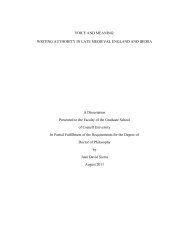Briana Anderson - Cornell University
Briana Anderson - Cornell University
Briana Anderson - Cornell University
Create successful ePaper yourself
Turn your PDF publications into a flip-book with our unique Google optimized e-Paper software.
• Attractive people are more persuasive (see: Baker & Churchill, 1977;<br />
Chaiken, 1979).<br />
Based on these studies of attractiveness in interpersonal relations, Patzer (1983)<br />
11<br />
conducted an experiment in which participants viewed fictitious advertisements that<br />
included three levels of attractiveness – low, medium, and high. The dependent<br />
variables included 1) perceived trustworthiness and expertise of the communicator and<br />
2) liking for the communicator if they were to meet. The results of the data analysis<br />
support the hypothesis that communicators of higher levels of attractiveness are<br />
perceived as more trustworthy and of higher expertise than those of lower<br />
attractiveness levels. The data strongly supported the hypothesis that attractiveness<br />
has a significant positive effect on liking of the communicator. Overall, the results<br />
offer evidence of a relationship between communicator physical attractiveness and<br />
perceptions of communicator expertise, trustworthiness, and liking regardless of<br />
communicator/receiver gender.<br />
Endorser Credibility and Corporate Credibility -- What’s the Relationship?<br />
Several studies have examined the effects of both corporate and source<br />
credibility on consumers’ attitudes toward the brand and advertisement, as well as<br />
purchase intentions. hile much advertising research has focused on the effectiveness<br />
of endorsers on consumer attitudes and behavioral intentions (as a function of the<br />
endorser’s credibility), more recent research has examined the role of corporate<br />
credibility as well. Researchers have examined endorser and corporate credibility as<br />
separate variables; this is generally conceptualized in the literature as companies<br />
concern for having a credible endorser represent their brand, while also being<br />
concerned with presenting a positive corporate image by engaging in socially<br />
responsible activities (Lafferty and Goldsmith, 1999) to enhance their corporate<br />
credibility.

















